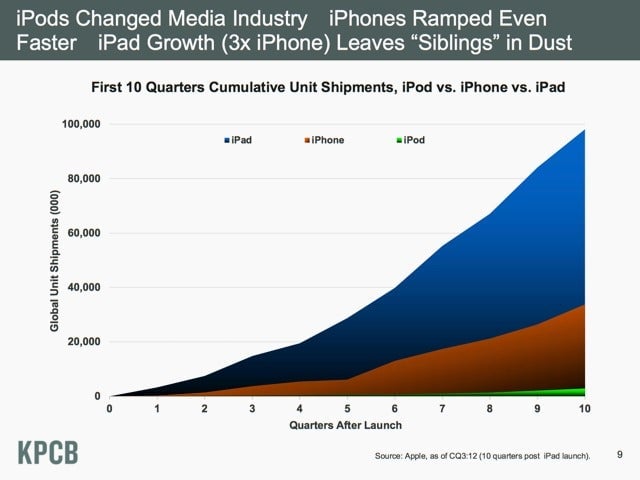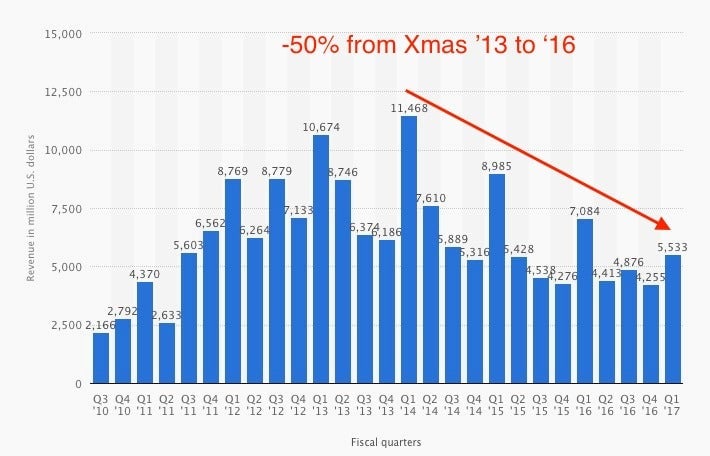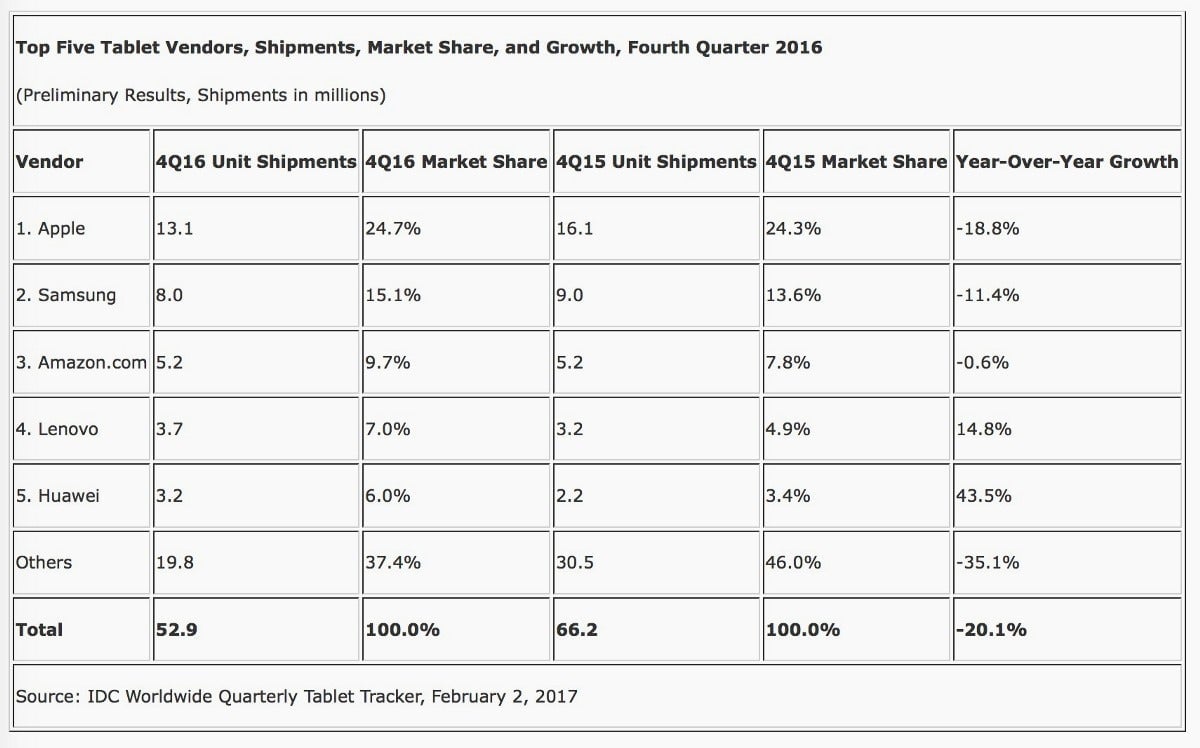Is Apple trying to turn the iPad into a Mac replacement?
Apple continues to profess optimism for the iPad even as sales continue to decline. In particular, the company hopes the new, beefier iPads will lure content creators away from conventional (and also declining) PCs. But how far will Apple go to blur the line between an iPad and a Mac?


Apple continues to profess optimism for the iPad even as sales continue to decline. In particular, the company hopes the new, beefier iPads will lure content creators away from conventional (and also declining) PCs. But how far will Apple go to blur the line between an iPad and a Mac?
On Jan. 27, 2010, Steve Jobs introduced what would become the first commercially successful computer tablet, the iPad. In her well-regarded “2012 State of the Internet” presentation, Mary Meeker shows the iPad’s meteoric growth, three times faster than the iPhone—the iPod left in the dust:

It didn’t last. Three years after it was introduced, iPad numbers peaked and fell, as shown in this Statista chart:

Over its second three years of life, iPad holiday sales declined by 50%, from 26 million units in Q1 2014 to 13 million in Q1 2017 (Apple’s fiscal year begins in October; the holiday season is Q1 of the following year).
The iPad’s fall was dramatic, but Apple wasn’t alone. According to IDC’s latest numbers the entire tablet market is in decline—a drop of 20% from 2015 to 2016:

What does this mean for the iPad, a product Apple CEO Tim Cook calls “the clearest expression of our vision of the future of personal computing?”
Without getting bogged down in hermeneutics, let’s divide tablets into two groups. The smaller devices, such as the iPad mini and inexpensive Android-powered “tablettes,” are used by “lean back” consumers to watch videos, browse the Web, and read email. The larger, more muscular tablets are aimed at graphic designers, bloggers, architects, artists, and other content creators.
Because of its simple, touch-based user interface (UI), the iPad mini is perfect for the lean back crowd. This is especially true of first-time computer users. I recall the delighted reaction of an older couple when I asked if they had had any trouble navigating their new iPad. “Oh no,” replied the gentleman with a big smile, “we’ve been going to the training sessions.” What makes the story particularly poignant is that his obviously arthritic right hand must have made PC use impossible.
Many experienced users rely on a small tablet as a complement to their “day job” computer. Reading books on the couch or in bed, checking news sites, updating your Facebook status…the iPad mini does a very good job.
The problem with all of this lean-back contentment is that it doesn’t breed desire. There’s no reason to buy this year’s “new and improved” model. The iPad’s elongated upgrade cycle, an affliction to which the iPhone appears to be immune, has ravaged sales. (This is something to keep in mind when company execs tout high customer satisfaction numbers… it may signal stagnation, at least for a while.)
Over in the “lean forward” camp, contentment doesn’t run so high. After an initial burst of interest in the iPad, content creators quickly realized that they couldn’t conduct their most important productivity tasks on such a machine. Yes, Tim Cook says he does all of his work on an iPad, and with his record of unimpeachable honesty, we do believe him. But one can honesty doubt he builds Numbers spreadsheets and graphs and incorporates those in Keynote presentations for Apple board of directors meetings. Annotations, yes; preparation, no.
A couple years after the iPad is introduced, Microsoft enters the picture with its hybrid Surface device. The tablet/PC has a touch-sensitive screen with a stylus and a traditional keyboard and mouse UI, and it’s bundled with a set of respected productivity applications including Word, Excel, and OneNote. Observers welcome the smart move, a 3.0 version of Microsoft’s historically successful “embrace and extend“ maneuver: Tablets are threatening our Windows PCs? We’ll build an all-in-one device!
(Since Oct. 2012, I’ve purchased three, starting with the short-lived [and perhaps to-be-born-again] Windows RT-based device running on an ARM processor; then the more conventional Intel-based Surfaces 2 and 3. I do this because I prefer discussing products from the paying customer’s perspective, having accumulated enough time to let the more durable Third Impression stabilize in my gut. As I wrote in a Feb. 2016 Monday Note, I felt the Surface device was better as a tablet than as a conventional PC.)
When the Surface was introduced, Apple execs colored themselves unimpressed. They mocked the device as a toaster-fridge and swore that the iPad would never tread the hybrid path. Steve Jobs proclaims that “if you see a stylus, they blew it.”
But only idiots never change their minds.
It’s now Sept. 2015: All hail the 12.9” iPad Pro…with a keyboard and stylus (pardon, a Pencil). This is followed, in Mar. 2016, by a 9.7” sibling. Critics point to the Pencil’s lack of a magnet to secure it to its iPad and to the awkward charging arrangement (forgetting, for the moment, that the Surface Stylus needs tiny alkaline batteries that aren’t always available at the airport).
The Pro, in name and in organs, is both an admission of error and a proposed solution: The original iPad can’t do enough for content composition/production, but the newer Pros will fill the previously unmet productivity needs.
So far, the remedy hasn’t worked. As the Statista chart shows, iPad revenue is still in decline eighteen months after the Pro introduction. Meanwhile, Mac numbers are up: Revenue +14%, units +4%. (Microsoft’s tablets have fared no better: The latest quarterly numbers show Surface revenue down 26% compared to this quarter last year.)
If we extrapolate the iPad evolution—a risky exercise in derivative thinking—we’re led to assume that the iPad Pro will usurp more MacBook functionality. One can imagine a version of iOS that offers multiple resizable windows, more file management features…
Follow this line of thinking and you’re led to a quasi-MacBook that has a detachable keyboard, a touch screen, a Pencil 2.0 with a magnet, and a somewhat simpler—but not too simple—user interface. To me, this is an uncomfortable contemplation; it could lead to a Swiss Army knife. Gone would be the respective simplicities of the original iPad and the well-honed MacBook.
Nonetheless, it’s not out of the question. We’ve seen before that Apple execs aren’t troubled by intramural cannibalization: Better to do it oneself than to be eaten by the competition.
What is questionable is the cost advantage for such a device. The Apple-designed Ax processor might cost less than the current Intel hardware in a MacBook, but memory (RAM) size will have to increase in order to support the new, more complex Pro UI. And then you have the added cost of a touch screen and of bundling the keyboard and stylus. A beefier iPad Pro won’t enjoy a sizable cost advantage. (For what it’s worth, today’s entry-level MacBook with 8 gigabytes [GB] of RAM and 256 GB of disk storage is priced at $1,249. A 12.9” iPad Pro with 256 GB of storage, a Smart Keyboard, and a Pencil will cost… $1247. And they weigh just about the same: 2 lbs [907 grams].)
It will be interesting to see how Apple finds ways to reboot iPad sales without bastardizing the device.